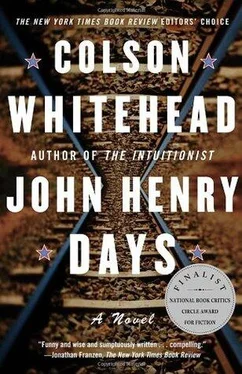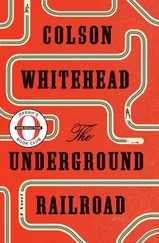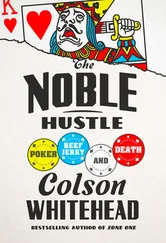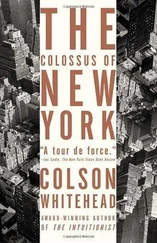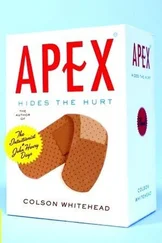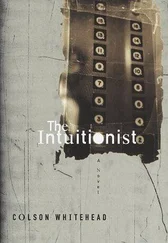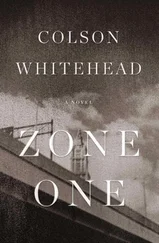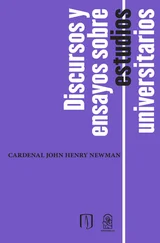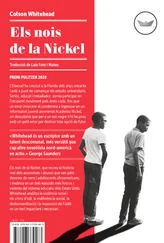“So you can drink John Henry whiskey.”
“It was just a special thing they put out for a short time. But my dad has, had, a few bottles.”
“These little telling details.”
“And you see those dents on the statue? People come around and use it for target practice. One time they chained the statue to a pickup and dragged it off the pedestal down the road there. Then the statue fell off and they drove off so they found it next day just lying in the road.”
“Probably not much to do here on a Saturday night.”
“Hmm.”
An energetic and determined clan moves in front them, driving them with gentle vulgarity away from the monument. While the matron wrestles her camera off her shoulder Pamela and J. withdraw into the parking lot. She asks him what he thinks.
“I thought it would be a lot bigger,” he says. The monument land is a shelf on Big Bend, the lap of a squatting giant. Chain-link fence keeps the people with two left feet from the cliff edge. On a day like today it earns its keep; there are varied hordes around J. and Pamela in search of justifications for the day’s drive over. Kids’ heads dart between boiled hot dogs and soda cup straws. Galoots lumber about snapping photographs and announcing how many pictures they have left. Some have purchased John Henry T-shirts and put them on over what they drew from the laundry this morning, to fit in with celebration, to pledge fealty to the day in 50–50 cotton and polyester. Bound to be a few of the clumsy type, statistic-wise, and the fences gird and protect. Most of the folks congregate around the food stalls, attempting to connect things they might have eaten, or at least described to them from visitors to foreign lands, with the missing letters on the menu. They mill there or by the red caboose, underneath the sign that reads JOHN HENRY PARK below the virile swirl of the Coca-Cola logo. Not much of an assignment. “I’m not sure if they had to fly me down for this, expense-wise,” J. says.
“This is just the monument,” Pamela counters. “The fair is over there by the tunnel.” She leads him to the fence and a vista of the fair, down there at ground level. The iron seam of the railroad tracks stretches directly below their feet, diving into the famous tunnel. Then there’s a thin strip of bone-white gravel and fencing and the fair itself erupts, eager, full of moving creatures negotiating white tents and each other, amid rippling streamers sad in the heat despite their exuberant colors, pulsating movement in the sun. There’s a nice turnout. The preparations have paid off. Between the three rows of booths and assorted attractions too small to make out from this vantage, where the people are, hundreds, it’s all unruly delight, what kind of cold heart despises the sincerity of a county fair on a summer day. The grounds extend for a quarter mile to the east, a ragged-edged flow. The eye is drawn to the south where the river writhes, seized by its own turbulent movement, and the mind can’t help connecting the two, the river of water and the river of people. Both move to their inevitable conclusions.
“Not bad,” J. says.
“Let’s see the caboose,” Pamela suggests, sounding suddenly more peppy than J. has seen her.
They move three feet and are reintroduced to the rules of moving in crowds. The necks of the more mindful glisten with suntan lotion. They shuffle forward. The line to the food and the line to the caboose get confused at one point (they have evolved too far from ants to remember how to work in such an insect boil) until the problem is sorted out by the more aggressive and J. and Pamela are before the door of the train car. There’s only one entrance, so as one or two exit blinking into the sunlight, they are replaced at the same rate. It doesn’t look as if the caboose ever saw any service on those tracks below. It doesn’t look sturdy at all, the wood planks more suitable for a backyard toolshed’s walls than a train car hustling on grooves at multiple horsepower. Pamela can see why they want to buy her father’s museum. Appropriately exhibited, the Street archive would fill a couple of these cars. A modest train. The John Henry Express. A young white couple from the city exit the caboose carrying a small figure. J. and Pamela enter the caboose.
Even if they were the only people inside, they’d still be climbing each other’s backs. Some of the clutter can probably be blamed on the previous fair-goers, who pick something up, replace, never matching the fastidious arrangement of the proprietor. But it’s still a haphazard assortment of wares. There are a stack of T-shirts in a soft slow topple along the right wall, and then a collection of figurines. The woman next to J. says, “This is cute,” lifting a three-inch-tall John Henry. John Henry ranges in size from toy soldier to lawn jockey, in a range of poses that produce an animated strip of steeldriving. John Henry holds his hammer at present arms, lifts his hammer to dare a lightning strike, brings his hammer down to ruin rock. On shelves above the counter, postcards are for sale. More than a couple are well-framed shots of the monument and the caboose in which they stand, a few more black-and-white shots of demolished C&O structures, the construction of the dam, various bucolic-minded scenes from the length of the New River. Merchandise. The air does not circulate, the wares exhale something not quite breathable, a gas more fit for whatever ceramic planets these objects call home. On the other wall clutter items unrelated to John Henry. Confederate flags in different sizes, T-shirts with said symbol. Available for purchase are miniature license plates that say Talcott and Hinton, suitable only for fairyland vehicles. In a row await diecast metal train cars, some even with wheels that move, if reluctantly. Books published by publishers outside the known New York zip codes describe the history of the region, the Chessie railroad system, West Virginia mining strikes, slim volumes with big type. The busy hands of tourists touch these things to test their solidity. They try to envision where these items might go in their households, mantels are conjured, knickknack nooks reconsidered. Everyone has a limit to how many T-shirts they can own, the figure varies with the individual. And yet the days are fleeting or so mirrors argue and souvenirs provide unimpeachable proof. A sign suggests, WHILE IN HINTON BE SURE TO VISIT HERB S.
Pamela says she’ll meet J. outside. She leaves before he can respond. Outside she can breathe again. Trying to relax all day and almost there until she saw one of the John Henry’s. It is identical to the one her father brought home twenty-five years before. The one that started it. It’s in a box up in New York. If the museum is going to have a gift shop, it will be full of stuff like that in there. She has a smoke and J. returns with a souvenir under his arm. It’s a mid-swing John Henry, of that vintage, two feet tall, and J. holds it like it’s a toddler. “It was only fifteen bucks,” he says.
“It’s nice,” Pamela murmurs. “Gonna carry that all day?”
“Hadn’t thought of that.”
“You want to head down there? I don’t think there’s much else to see here.”
“What time is the taxi coming back?”
“We have to walk.”
“All the way down there?”
“All the way down there with John Henry under your arm. And your fly is open.”
They walk, he adjusts.
When the Sepia Ladies Club convenes in the downstairs parlor of the Sutter household Jennifer is conscripted into serving duty. Her mother fusses over her hair, pronounces it a bird’s nest, then says there’s my princess after taming brush. When the Sepia Ladies take the teacups from the serving platter in their white gloves, they tell Jennifer how pretty she looks. One by one down the crescent of soft chairs as they sip. The ribbons in her pigtails deserve no small portion of blame for these compliments, if their comments on how delightful they look are any indication. Her mother twists them a certain way. The women pinch her cheeks. Jennifer lingers in the doorway, scratching her right ankle with her left foot, as the Sepia Ladies go through the minutes and from time to time her mother tells her to fetch more crackers from the kitchen, where Jennifer sets them in mandallic arrangements on a silver platter. From what she can tell, they don’t talk about anything. Nothing she cares about anyway. Mrs. Jackson (who could not attend this meeting) is acting all uppity because her husband bought that new emerald Cadillac, but it doesn’t matter because Mrs. Greenley saw him outside the grocery store at noon and she swears she smelled liquor on his breath, it runs in the family, but we shouldn’t talk about Mr. Jackson’s father and the turpentine. Mrs. Barden (who has been attempting to join the Sepia Ladies Club for some time now but does not understand she has to earn her place and that bragging about her Creole blood is not going to do the trick) and her husband moved into the corner brownstone on 138th Street and have fixed it up all nice (from what they can see from the outside; Mrs. Barden has not graced these women with an invitation to her abode) with lace curtain ordered from an English catalog, but maybe she should be less worried about their nice lace and spend more time thinking about her young Angelique talking to the no-good shiftless Negroes who work at Hope’s Garage, spend less time bragging about how her grandfather went to Harvard and the award he won for his speech about freedom in Haiti and more time thinking about their daughter’s carrying-on.
Читать дальше
Конец ознакомительного отрывка
Купить книгу
